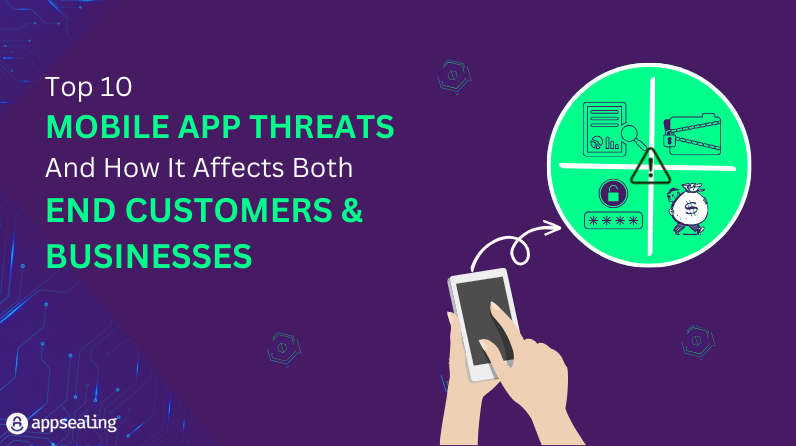Mobile apps are crucial for personal and business use, but they come with risks. Mobile app threats can compromise sensitive data and threaten security. These risks are heightened by new technologies and evolving attack methods.
Secure mobile app design is crucial to prevent data breaches and financial losses. Threats include malicious code injection, credential stuffing, phishing, and social engineering. MitM attacks intercept and manipulate network communications, while Bluejacking annoys Bluetooth device owners.
Top 10 Mobile App Threats
-
Malicious Code Distribution Through Malware
Mobile app threats come in various forms such as viruses, worms, Trojan horses, and ransomware, each using a different attack vector to cause harm. These can be spread through various mediums as mentioned below –
- Email AttachmentsThreat actors distribute malware to unsuspecting individuals in the form of an email attachment. The installation of the malware occurs on the user’s personal computer upon opening the attachment.
- Downloaded Files
Downloading malware from websites or file-sharing platforms remains a plausible scenario. Mobile app threats can be implanted onto users’ computers while downloading files. - Infected Websites
Infected websites have the potential to host malware, which can be downloaded to a user’s device upon visiting the compromised page. - Social Media
Mobile app security threats have the capability to propagate through social media. For instance, an individual might click on a malicious link within a social media post, installing malware on their device. - USB Drives
USB drives can carry malware, and this malware gets installed on a user’s computer as soon as the USB disk is inserted.
-
Data Breach
When unauthorized individuals gain access to sensitive data stored in a computer system, network, or database, it is considered a “data breach.” This term is used to describe a catastrophic event in the world of cybersecurity. Sensitive data, including private, financial, or proprietary information, can be inappropriately altered, stolen, or disclosed during a breach. Breaches can occur in a variety of ways.
- Hacking: To obtain private information, hackers employ diverse methods, including phishing emails or software exploits.
- Insider Threat: It is a mobile app security threat flaw that results from someone accessing private data. Insider threats can be intentional, such as when an employee steals information to benefit themselves, or careless, such as when an employee accidentally exposes information.
- Physical Theft: Sensitive data can also be threatened if it is physically stolen, such as when a mobile phone or other device is lost or stolen.
- Data Loss: Furthermore, sensitive data may be destroyed, corrupted, or irrevocably ruined as a result of human operational failures or the impact of catastrophic events such as floods, fires, or other natural disasters.
-
Unreliable Third-Party APIs
Mobile apps commonly use client-server architecture, where app stores like Google Play act as clients for end-users to engage in activities like purchases, messages, and notifications.
On the developers’ end, the server component communicates with mobile devices through an internet-based API, ensuring accurate execution of application functions and overall performance.
Mobile app threats are embedded within this infrastructure. 40% of server components have subpar security postures, while 35% have highly critical vulnerabilities. These issues require a comprehensive strategy to enhance mobile application security measures and architecture.
-
Inadequate Authentication
A significant flaw in digital systems, especially mobile apps, is weak authentication. Users who require access to sensitive information or services must be authenticated before their requests can be processed. However, serious dangers emerge if authentication processes are poorly developed or carried out.
In such scenarios, unauthorized entities exploit inadequate authentication controls to gain unauthorized access, leading to significant threats to businesses and end customers. These mobile app threats are attributed to vulnerabilities like weak password practice, lack of Multi-Factor authentication (MFA), or inadequate session management.
Attackers exploit inadequate authentication in several ways to gain unauthorized access.
- Credential Stuffing: Using stolen credentials from one breach to access other accounts with the exact details.
- Password Spraying: Exploiting common passwords across multiple accounts, targeting weak or default ones.
- Phishing: Tricking users into revealing credentials via deceptive emails or websites.
- Session Hijacking: Exploiting unprotected session tokens for user impersonation.
- Bypassing Authentication Steps: Exploiting process flaws to evade required steps.
- Cookie Theft: Stealing session cookies to impersonate authenticated users.
- Insider Threats: Exploiting internal knowledge of weak authentication methods.
- Insufficient MFA: Weak or absent multi-factor authentication lets attackers bypass security layers.
- Account Enumeration: Detecting valid usernames via system responses, aiding future attacks.
-
Shoddy Encryption
A digital system, such as a mobile app, with weak cryptographic protections is said to have “shoddy encryption.” Encryption is crucial to security since it encrypts sensitive information to make it inaccessible to intruders.
Data breaches might occur due to irresponsible encryption policy selection, poor implementation, or unplanned deployment.
Attackers can exploit shoddy encryption in various ways to compromise mobile application security.
- Brute Force: Attackers try all possible combinations to crack weak encryption keys or algorithms.
- Cryptanalysis: Exploiting patterns or vulnerabilities in poorly implemented encryption for data decryption.
- Dictionary Attacks: Using precomputed dictionaries to decrypt data from easily guessable encryption keys.
- Eavesdropping: Intercepting and decoding weakly encrypted data transmitted over networks.
- Replay Attacks: Intercepted encrypted data is replayed for unauthorized access.
- Man-in-the-Middle: Attackers alter communication, exploiting shoddy encryption.
- Key Management: Stealing or manipulating poorly managed encryption keys to decrypt data.
- Padding Oracle: Exploiting weak padding schemes to reveal encrypted data.
- Side-Channel Attacks: Gleaning information from unintended sources like power usage or timing.
- Key Length Reduction: Weakening encryption by shortening key lengths, aiding attacks.
-
Unpatched Existing Vulnerabilities
Unpatched security flaws have been identified in a system or component of software but have not yet been patched by the developers.
Attackers use these vulnerabilities to obtain unauthorized access, compromise data, or carry out unwanted activities. Here’s how attackers exploit unpatched flaws:
- Exploit Kits: Attackers deploy kits targeting unpatched vulnerabilities on compromised websites to deliver malware.
- Zero-Day Attacks: Exploiting undisclosed vulnerabilities, attackers challenge defenses until patches emerge.
- Ransomware: Unpatched systems fall prey to ransomware, with attackers exploiting vulnerabilities for initial access.
- Remote Code Execution: Vulnerabilities enable remote code execution, granting control over systems or apps.
- Data Theft: Attackers exploit vulnerabilities for unauthorized data access, risking breaches.
- DDoS: Vulnerabilities fuel DDoS attacks by compromising devices for botnet creation.
- Credential Theft: Stolen credentials stem from vulnerabilities, granting access and privileges.
- Privilege Escalation: Vulnerabilities utilized to gain higher system access magnify the potential harm.
- Malware Delivery: Through infected files, vulnerabilities serve as entry sites for malware.
- Evasion: Unpatched vulnerabilities are exploited by attackers to circumvent security measures.
-
Unsafe Environment: Rooting/Jailbreaking
In the context of mobile device security, an unsafe environment is created when users modify their devices’ operating systems beyond the permitted constraints.
The term “jailbreaking” refers to the method through which consumers of mobile devices gain complete access to the core of the operating system (OS) and the ability to control all application functionalities. The term “rooting” describes the process of eliminating constraints from a mobile phone that is running the application.
Rooting (for Android devices) and jailbreaking (for iOS devices) are ways to gain superuser access, which allows users to circumvent restrictions and install unlicensed programs. Attackers use the following risky tactics to breach device security:
- Malware Distribution: Attackers create malicious apps and distribute them through unofficial app stores or websites targeting rooted or jailbroken devices.
- Data Theft: Rooted or jailbroken devices are more vulnerable to data theft due to weakened security measures, facilitating unauthorized access to sensitive information.
- Privilege Escalation: Attackers use rooted/jailbroken devices to gain control over system functionalities and user data.
- Botnets: Devices that have been jailbroken or rooted are enlisted into botnets for massive attacks like DDoS.
- Keylogging: Attackers employ keyloggers to record private user inputs like passwords and credit card numbers on infected devices.
- Insecure Apps: Rooting/jailbreaking allows the apps with excessive permissions to be installed, increasing the attack surface.
- Financial Fraud: Attackers target rooted/jailbroken devices for banking Trojans and fraudulent transactions.
- Evasion of Security Measures: Attackers modify system files to bypass security mechanisms, making detection and protection more challenging.
-
Unsecure Network Connection
Data exchange occurs across carrier networks and the Internet within the client-server architecture of mobile app security.Vulnerabilities in this traversal process open sources for attackers to execute malware attacks, intercepting stored confidential data over WiFi or local networks. These vulnerabilities leave end users susceptible to account theft, site exposure, phishing, and man-in-the-middle attacks. Businesses may experience privacy violation charges and suffer from fraud, identity theft, and reputational loss. A robust defense approach against these vulnerabilities involves implementing SSL/TLS security on the transport layer, employing trusted CA certificates, and adopting strong cipher suites. These measures bolster encryption, ensuring secure data transmission, safeguarding users, and protecting businesses from potential threats.
-
Overprivileged Applications
Applications that have been given more substantial access to device resources and data than they need to operate effectively are called overprivileged applications on mobile devices. The following reasons make this a severe threat to the security of mobile applications:
- Data Privacy Violation: With excessive permissions, these apps access personal data, contacts, locations, and messages resulting in privacy breaches.
- Malicious Exploitation: Attackers exploit overprivileged apps to gain authorized access, leading to identity theft, financial fraud, and cyberattacks.
- Privilege Escalation: Overprivileged apps are gateways to escalate privileges, potentially controlling the device or Operating System (OS).
- Data Leakage: Overprivileged apps inadvertently/deliberately leak sensitive data, compromising confidentiality.
- Resource Exhaustion: Excessive permissions cause overprivileged apps to consume excessive resources, resulting in performance issues.
- Third-Party Exploitation: Overprivileged apps become attacker targets for exploiting permissions maliciously.
- App Vulnerabilities: Extensive permissions in overprivileged apps expand the attack surface, increasing vulnerability to exploitation.
- App Collusion: Malicious apps collude with over privileged ones to bypass security, compromising user data.
-
Susceptible Third-Party Components
Susceptible third-party components refer to external software, libraries, or modules integrated into an application’s codebase, which contains vulnerabilities that attackers can exploit.
These components, often sourced from third-party developers or open-source projects, introduce security threats to the mobile application ecosystem:
- Outdated Versions: Using obsolete components exposes apps to known vulnerabilities, lacking patches from recent versions.
- Unpatched Vulnerabilities: Neglecting security updates keeps apps at risk from exploitation via acknowledged vulnerabilities.
- Insecure Defaults: Third-party components with insecure default settings provide openings for app compromise.
- Malicious Code: Compromised components introduce backdoors, malware, and harmful code into apps.
- Dependency Chain: One component’s vulnerability propagates to interconnected ones, heightening overall risk.
- Documentation Gaps: Inadequate or unclear documentation leads to misused components and vulnerabilities.
- Supply Chain Attacks: Attackers manipulate upstream sources to infuse vulnerabilities into widely used components.
- Zero-Day Vulnerabilities: Recently uncovered component vulnerabilities were exploited prior to patches being released.
How do these Mobile Application Threats Affect the End Customers?
The above-mentioned mobile app threats significantly impact end customers.
- Malicious code distribution through malware can lead to unauthorized data access or device control, potentially resulting in data compromise or financial losses
- Data breaches expose users’ sensitive information, causing privacy violations and facilitating identity theft.
- Unreliable third-party APIs jeopardize data integrity and availability, affecting user experience.
- Inadequate authentication opens avenues for unauthorized access, leading to unauthorized transactions or data exposure.
- Shoddy encryption weakens data protection, enabling unauthorized decryption and tampering.
- Unpatched vulnerabilities create entry points for attackers, risking malware infections or data theft.
- Unsafe environments, such as rooting or jailbreaking, undermine a device’s security, making it more susceptible to malicious actions.
- Unsecured network connections make data susceptible to interception and manipulation, thereby compromising confidentiality.
- Due to excessive permissions, overprivileged applications can compromise sensitive data or device functionality.
- Vulnerabilities are introduced by vulnerable third-party components, paving the way for unauthorized access or data intrusions.
How Mobile Apps Threats Affect Businesses with Confidential Data?
Sensitive data businesses are at risk from mobile app threats, especially in BFSI. Data breaches, inadequate authentication, and malicious code dissemination in Real Money Game (RMG) apps can lead to financial losses and reputational damage. E-commerce apps are also at risk of compromising personal and financial information, leading to legal action and loss of trust.
Healthcare companies need strong security practices to protect patient information, comply with regulations, and maintain client trust.
-
Banking, Financial Services, and Insurance (BFSI) Sector Apps
The BFSI industry faces significant risks from mobile app threats, including unauthorized access to financial data and transactions. Data security breaches can damage customer confidence and reputation. To protect users, robust encryption, multi-factor authentication, and continuous security assessments are essential.
-
Real Money Gaming (RMG) Apps
Most mobile app threats can have disastrous consequences for Real Money Gaming applications. The spread of malicious code via malware can compromise consumer payment information, which may result in financial losses and legal action.
It is conceivable that untrustworthy third-party APIs might compromise the game’s security and expose user information. An inadequate authentication approach may result in unauthorized access, thereby facilitating deception and phony activities.
Implementing rigorous safety standards, routine code audits, and secure payment gateways are required to preserve users’ trust and safeguard their financial transactions.
-
E-commerce Apps
E-commerce app usage is significantly impacted by mobile app threats. Data breaches can expose consumers’ payment information, which can result in monetary losses and legal repercussions.
Improper access to user accounts and potentially sensitive personal information could result from insufficient authentication. Client information may be compromised if a transaction is conducted over an unsecured network connection.
To protect client data and maintain the integrity of e-commerce transactions, it is necessary to employ robust encryption, employ multi-factor authentication, and conduct routine IT security audits
-
HealthCare Apps
Mobile app threats pose a significant obstacle for the healthcare app industry. Confidential patient records could become public in the event of a data intrusion, violating privacy laws and exposing the organization to legal consequences.
Inadequate encryption may affect patient confidence, jeopardizing their right to privacy regarding their medical information. Unreliable APIs provided by third parties could compromise the data’s integrity and the quality of patient care.
To secure the privacy of patients from mobile app security threats, comply with applicable laws, and maintain the credibility of healthcare providers, it is essential to implement stringent authentication and encryption protocols.
Security Recommendations
- Remote work is prevalent, but only 13% of organizations use critical safeguards: data encryption, limited access, no default passwords, and security testing.
- About 50% lack vital acceptable use policies, essential for countering mobile data security threats and setting employee device and network behavior standards.
- IT teams should adopt mobile device management, utilize MFA and single sign-on (avoid SMS), and embrace Zero Trust Model for security.
- Regular employee training is crucial, prioritizing security and informing about the latest cyber threats.
- Employees must grasp common mobile app threats and identify signs of attempted attacks.
- Adhere to organizational policies and proactively secure their devices.
- Use robust passwords and adopt enhanced authentication like MFA and biometrics.
- Ensure home networks’ security and avoid unsecured public WiFi.
- A good Runtime application self-protection (RASP) based security like AppSealing can help your application stay safe from such cyber intrusions. It will not only recognise, detect and block but it will also provide you with the necessary analytics to ensure you block such users.
Final Thoughts
Security is a continuous effort that requires constant monitoring and evaluation of policies and methods. It takes time and resources to establish a strong and reliable defense for mobile app security threats.
Securing a business network requires careful planning, strong technology, and skilled professionals. Every step towards improved security is crucial in protecting digital assets, sensitive data, and business operations.
In this dynamic cybersecurity landscape, a systematic and gradual approach is critical to achieving a resilient security posture that stands the test of time. One easy and efficient way of ensuring safety from mobile app threats is to have AppSealing’s RASP based robust mobile app security.






